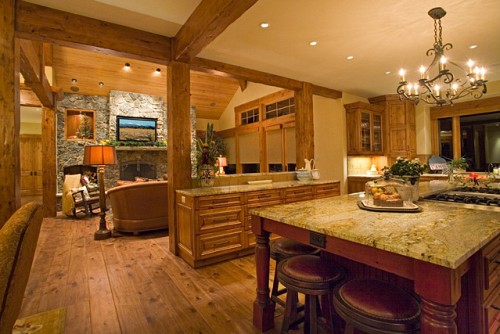Heat Your Open Plan Home Up and Keep Fuel Bills Down
An open plan home offers a lot to love – more light, more room, and a less cramped feeling than you’d generally have with a traditional-style house or condo. Unfortunately, this popular housing design is not without its drawbacks. Folks who live in open spaces usually describe their Number One problem with this type of layout as the difficulty and expense in effectively heating their home when the chilly season starts. Here are 6 solutions that will warm you up -- while still keeping your heating bills down -- in an open plan abode.
- Seal and insulate. Caulking and sealing any cracks or crevices in your home’s envelope (in spots like the perimeter of your windows and exterior doors) and retrofitting insulation are vital energy-efficient measures. no matter what your home style may be. They are all the more essential, though, when you live in an open plan residence … where, otherwise, unwanted cold breezes will blow freely through your living space.
- Use a ceiling fan to blow warmth your way. Make the most of your HVAC system’s output -- adjust your ceiling fan to direct heated air downward. Check the fan manufacturer’s directions to find out exactly how to accomplish this clever heat trick; usually, it’s just a matter of simply changing the fan from its “forward” to “backward” setting. Just remember to switch the settings back when winter finally ends.
- Supplement your main heating source. Funny, but even if you’ve got a wide open area measuring several thousand square feet, it seems that household members have a peculiar tendency to flock together in one cozy corner. (Herd instinct, perhaps?) Add warmth to that favorite gathering spot with a child-safe, plug-in, oil-filled radiator or baseboard space heater or -- for a more upscale ambiance -- try a natural gas or electric fireplace.
- Close out the cold. A basic principle of keeping an open plan home nice and toasty is minimizing heat transfer. In layperson’s terms, that means “warm air stays in; cold air stays out.” The best way to accomplish this may seem counter-intuitive to diehard open plan fans, but it does work. Opt for a few (possibly temporary) divisions. Some of the best suggestions we’ve come across are building a vestibule or mudroom adjacent to your house's front and back entrances, installing unobtrusive folding or pocket doors, and hanging curtains in strategic locations, such as across the foot of a staircase.
- Plan warming window treatments. Hang thermal drapes or on-trend wooden plantation shutters as attractive multitasking window treatments ... these decor accemts will do dual duty by keeping your open space comfy. Close them against the cold when those oh-so-early winter evenings set in, but then open them the next morning to reap the warming benefits of sunlight during the day.
- Warm the floor. Finding an HVAC pro to install radiant underfloor heating is highly recommended; hydronic (water-based) works better than electric radiant heating in most open plan homes. Underfloor heating can be added in when you construct a home or remodel an existing one (but if you don’t envision new flooring in your immediate future, you’ll find that wall-mounted radiant heating is easier to retrofit). Covering your cold floor with plush area rugs or a thick carpet is an easy DIY, budget-friendly alternative.
Laura Firszt writes for networx.com.
Updated April 16, 2018.
Looking for a Pro? Call us (866) 441-6648

Heating & cooling Average Costs
HVAC Contractors Experiences

In 123-Degree Heat, Air Conditioning Replacement Was A Must

I Needed A New Gas Furnace Install Due To A Cracked Burner

Installing Nest Thermostat Almost As Hard As Learning To Use It
Top Cities Covered by our HVAC Contractors
Austin
| Boston
| Charlotte
| Chicago
| Columbus
| Dallas
| Denver
| Detroit
| Fort Worth
| Houston
| Indianapolis
| Jacksonville
| Los Angeles
| Memphis
| Nashville
| New York
| Philadelphia
| Phoenix
| Portland
| San Antonio
| San Diego
| San Francisco
| San Jose
| Seattle
| Washington



